Backyard pools have come a long way over the years.
Today, there are various options you can choose from when it comes to construction and design. Each has its pros and cons, which can be overwhelming if you’re left to figure everything out on your own.
So let’s do a full comparison of fiberglass, concrete, and vinyl liner swimming pools, so you can pick the one that’s right for you.
Fiberglass vs Concrete vs Vinyl Pools
There are 3 different types of pools to choose from: fiberglass, concrete, and vinyl.
Learning about each can help you understand which one will be the best value for your dollar.
What Shapes/Sizes Do They Allow For?
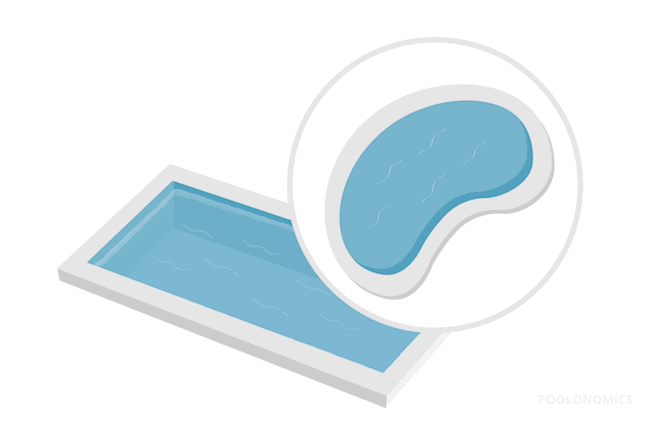
In case you haven’t noticed, pools come in all sorts of shapes and sizes, from basic rectangles to lavish lagoons. Some pools can be designed however you wish, while others are limited in what you can do with them.
- Fiberglass: Fiberglass pools are ready-made from molds (think of them like a giant bathtub). This means they can only be specific shapes and sizes. However, they still come in a wide range of choices: rectangular, Roman-inspired (rectangular with arched ends), kidney bean, and freeform. sizes vary but they have a maximum footprint of 16 x 40 due to transport restrictions on public roads.
- Concrete: Concrete pools can be any shape and size you wish. Building from the ground up means you have full control over the pool’s look and depth. As you’re not restricted to a specific size, you can build as big as you want. Some custom concrete pools are shaped like a heart or guitar to create something truly memorable.
- Vinyl Liner: Vinyl lined pools give you more shape and size flexibility than a fiberglass pool, but not as much as a concrete pool. They use a series of wall panels that are attached together to form the perimeter, which can be shaped into most standard pool designs. They also allow control over the pool’s depth and can be built to as large a size as you wish.
Winner: If you want total design freedom over your pool, concrete is the way to go. There’s no limit when it comes to shape or size, and you can control the depth throughout the entire structure.
What Colors/Finishes Do They Allow For?
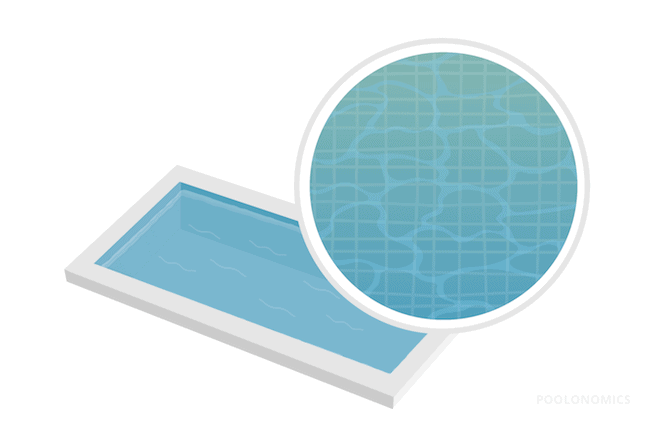
The finish that’s put on the pool walls and floor can not only protect the structure, but also make things a lot more comfortable for swimmers to stand on.
- Fiberglass: Fiberglass pools use a gel-coating that comes in a variety of colors: various shades of blue, white, or grey. Lighter colors will keep the water tropical-looking, while darker shades make the water look more like a lake. Fading of this gel finish will take decades, and you should get between 20 and 30 years of use before needing to resurface it.
- Concrete: Concrete allows for the widest range of finishes to choose from. From basic epoxy paint, to plaster, to aggregate, or tiles, all can be used with a concrete pool. On average, epoxy paint will last 5 years, 7 to 10 years for plaster, aggregate is between 10 and 20 years, and tiles can last a lifetime.
- Vinyl Liner: Vinyl liner pools use a vinyl liner as their “finish”. While they’re relatively easy to install, they are also the most delicate to deal with, and can be easily damaged. Additionally, the shelf life of a liner is between 5 and 10 years. This means you’ll be spending a few thousand dollars each time you need to replace it.
Winner: Concrete pools win this round, as they have 4 different options you can choose from to put the finishing touches on your pool surface.
What Other Customizations Do They Allow For?
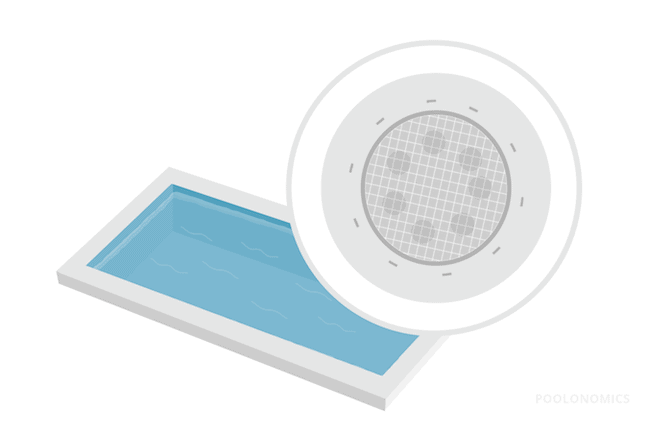
There are lots of custom options for pools these days. Things like pool water features, lighting, coping, and the type of decking can all be added and designed to your specifications.
- Fiberglass: Depending on the mold, you can get fiberglass pools with cutouts for underwater lights, or an extended entry with a tanning ledge. Adding in water features like deck jets, bubblers, and waterfalls can also be done with these pools.
- Concrete: Pools designed from concrete usually allow for a bit easier customization as everything is built from scratch. Many high-end pools are made from concrete so you’ll see a lot of splashy features (pun intended) like water walls, fountains, and scuppers to give it a dramatic flair.
- Vinyl Liner: Customizing a vinyl liner pool is also possible. Also, the entry steps to these pools can either be a white polymer (which attaches to the exterior of the wall panels), or you can have premade vinyl over steps crafted when laying the foundation for the pool’s flooring for a more luxurious entry.
Winner: This category is a draw, as they all can be customized in various ways, although concrete pools seem to have the most upscale bells and whistles designed into them.
How Do They Feel To The Touch?
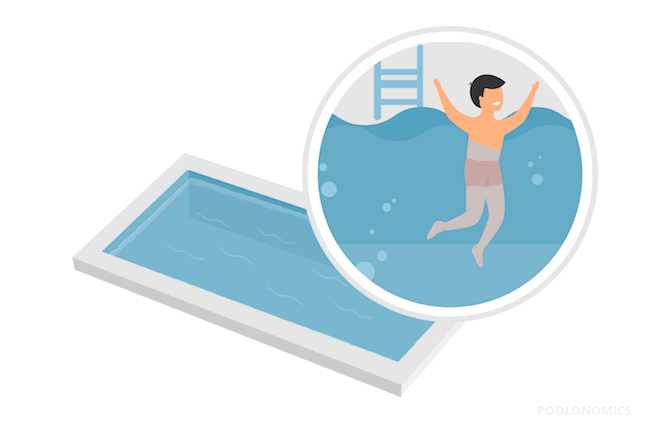
Comfortability is important when it comes to swimming. So how does each one measure up?
- Fiberglass: The gel coating on fiberglass pools make it the smoothest finish available. Additionally, it’s also anti-slip, adding a level of safety so you don’t wipe out when entering and exiting the pool.
- Concrete: As concrete finishes vary, so do their textures. Epoxy paint is literally just a paint job on concrete, and many a stubbed toe has been cut open on this finish. Plaster is smooth but bumpy, aggregate can be smooth like fiberglass, or textured for more grip, and tiles will be smooth but textured as well.
- Vinyl Liner: Liners come in either embossed or non-embossed varieties. Embossed liners have peaks and valleys in their surface, making for a soft, squishy feel under foot. Non-embossed liners are flat with a uniform thickness – still smooth, but not as comfortable as embossed liners.
Winner: When it comes to feel, it’s hard to beat the fiberglass gel finish. It’s smooth and comfortable to walk on and has enough grip on it for added safety.
How Do They Impact Water Chemistry?
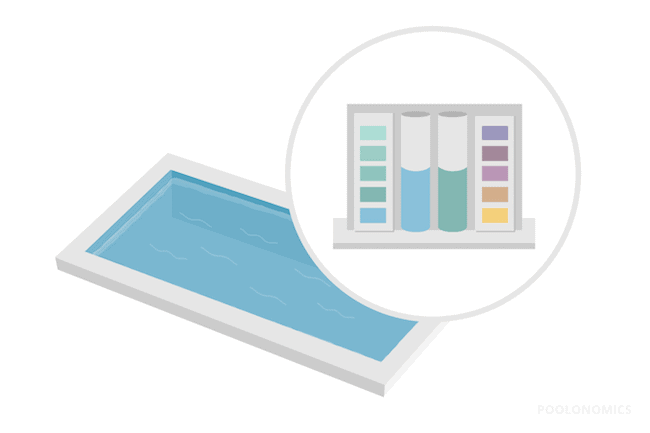
Does the material the pool is made of affect the water’s chemistry? Let’s find out.
- Fiberglass: These pools don’t affect water chemistry at all because of the inert nature of the fiberglass and the gel finish. The finish also includes an anti-algae agent, to help keep algae from blooming in your pool. Also, fiberglass pools will keep your water warm because there’s no heat transfer through the walls and out of the pool, meaning you’ll blow through chlorine faster. If you use a heater this is probably something you’re prepared for though.
- Concrete: Concrete is an alkaline-based material. Unfortunately, that means that it will slowly tip the balance of the water into alkaline territory. If the water becomes too alkaline, problems with cloudy water, scaling, and damage to your equipment can occur. So you’ll need to stay on top of water testing with this pool.
- Vinyl Liner: Vinyl liners act much the same as the fiberglass gel finish, as they’re also non-porous and barely affect the water chemistry. However, vinyl liners are prone to algae blooms in areas of the pool where water circulation is low (ie. around steps, ladders, skimmers).
Winner: The inert nature and anti-algae properties of the fiberglass gel finish give it a decided advantage over the concrete and vinyl liner options.
How Easy Are They To Maintain?
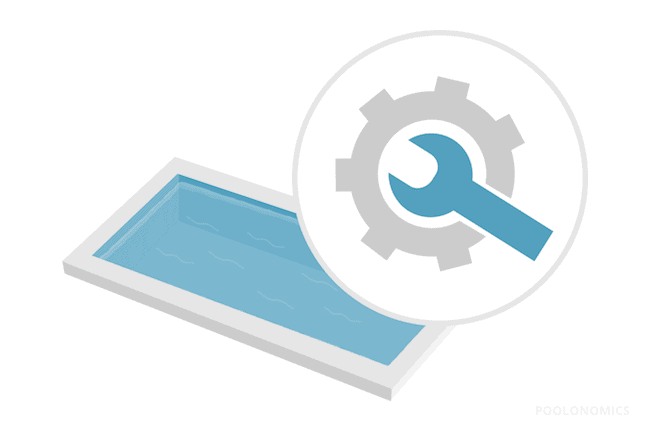
Let’s be honest, keeping your pool clean can be a hassle even at the best of times. So which pool is the easiest to maintain?
- Fiberglass: One of the selling points of fiberglass is that it’s extremely low maintenance. The gel finish makes it hard for debris and algae to stick to it and grow, and it needs little more than weekly maintenance using the appropriate cleaning tools and a mild cleaner.
- Concrete: Concrete pools are the opposite. Due to their porous nature, they’re prone to algae, need to be vigorously brushed down regularly, can develop cracks in the foundation, and the concrete can be corroded if you have high levels of calcium in a saltwater pool. Also, if the pool has a plaster finish, it will need to be acid washed every 5 years to get rid of stains that have accumulated on it.
- Vinyl Liner: Vinyl liners require specially formulated cleaning solutions to keep the vinyl from breaking down, as harsh cleaners will eat away at it. Keeping this pool clean on a regular schedule will help prolong the lifespan of the liner, although it will be necessary to fully replace it every 5 to 10 years.
Winner: Fiberglass pools win this round hands down. Not only do they clean easily, but they stay clean the longest, and have the least amount of maintenance over the lifetime of the pool.
How Long Do They Usually Last?
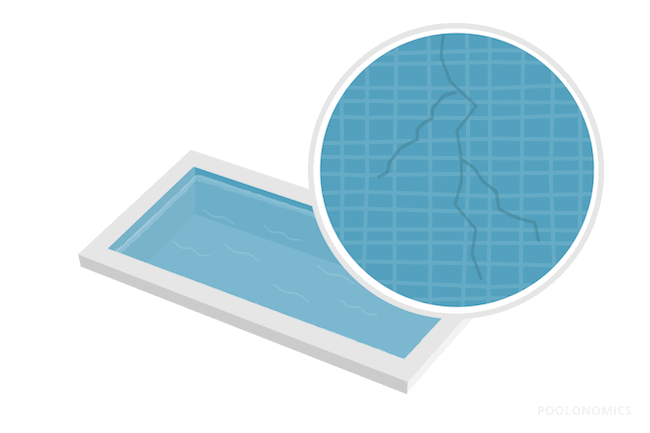
So how much life can you get from these pools?
- Fiberglass: Fiberglass pools are designed to last a long time. They come with two warranties – one on the fiberglass structure, and one on the gel finish. The structure itself should last upwards of 50 years, and the gel finish between 20 and 30. Resurfacing the finish can be done to get more life from the pool rather than replacing the entire structure.
- Concrete: Concrete pools last the longest if well taken care of. Resurfacing a paint/plaster/aggregate finish will all have to be done at some point, but if you finish a concrete pool with tile there’s a good chance you’ll never have to resurface it.
- Vinyl Liner: The structure of a vinyl lined pool can easily last 30+ years, but the liner itself usually needs replacing every 5 to 10 years. There are some people who claim to get more close to 15 years out of their liner, although this most likely depends on how well you maintain it, and if you can live with the stains and discoloration it picks up over time.
Winner: Concrete has the longest lifespan if coupled with a tile finish, but fiberglass pools also afford you decades of use before any resurfacing or major maintenance will have to be done to the pool.
How Easy Are They To Install?
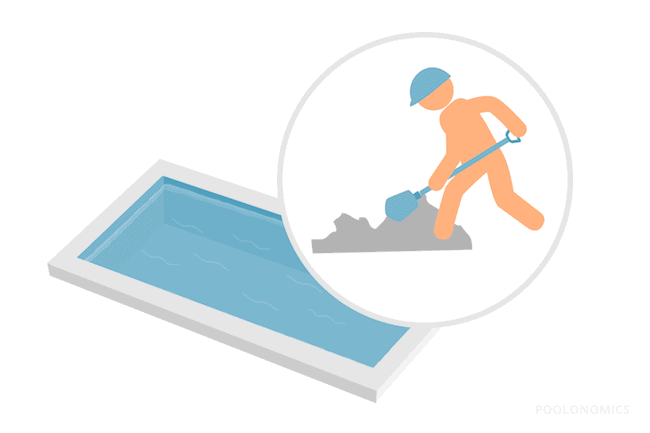
Installing a pool is always going to be a big project, but some are easier to do than others.
- Fiberglass: Fiberglass pools have an average installation time of 3 to 6 weeks. This makes them the fastest out of all the pool types. This is because the pool shell is ready to go, which saves a considerable amount of time. Some people can even install them in a matter of days if they know what they’re doing.
- Concrete: Creating a pool with concrete is the most laborious way to do it. The trade off is a long-lasting pool, but the install time for a concrete pool is anywhere from 3 to 6 months. This of course also depends on how intricate the design is, but be prepared for your backyard to become a construction zone for an entire summer.
- Vinyl Liner: The option in between fiberglass and concrete, vinyl liner pools take around 4 to 8 weeks to install. This is because the perimeter walls require building, and the floor needs to be constructed from either grout or vermiculite.
Winner: Fiberglass pools are the way to go if you want your pool to be constructed in a short amount of time so you can spend your summer swimming in it, rather than just building it.
How Much Do They Cost?
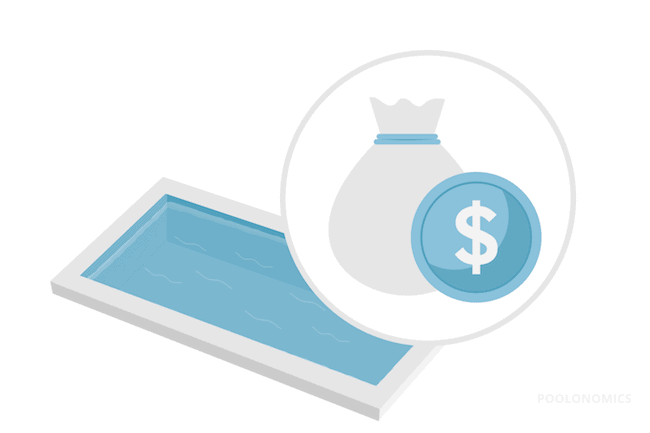
Now we get to the heart of the matter – what will each option cost you?
- Fiberglass: The average price for a fiberglass pool is $40,000. The shell itself can cost anywhere from $10,000 to $40,000, but adding in labor as well as extra bells and whistles will add to the cost. Of course, the size and quality of materials also play a role, and can increase the price to $70,000 for the most high-end designs. Resurfacing the gel finish will set you back around $6,000.
- Concrete: The raw materials, as well as the intensive labor that concrete pools require make it the most expensive pool option, averaging around $75,000. As previously mentioned, depending on any extra features you want to add to the pool, you could be looking at upwards of $100,000 for the overall cost. Depending on the finish, you’ll have to resurface it at some point, which could cost anywhere from $1000 for epoxy paint, to $5,000 for plaster, and $13,000 for a new aggregate finish.
- Vinyl Liner: Vinyl pools start at around $25,000, making them the least expensive upfront option. However, with the liner requiring replacement every 5 to 10 years, you’re looking at an additional $5,000 each time.
Winner: Fiberglass pools give you the best value for your money. Not only do they last a really long time, but they require the least amount of maintenance. And with resurfacing only needing to be done every 20 to 30 years, you’ll get plenty of life from it.
Comparison Summary
| Fiberglass | Concrete | Vinyl Liner | |
| Shapes/Sizes | Good | Best | Very Good |
| Colors/Finishes | Very Good | Best | Good |
| Other Customizations | Draw | Draw | Draw |
| Feel To The Touch | Best | Good | Very Good |
| Water Chemistry | Best | Good | Very Good |
| Maintenance | Best | Good | Very Good |
| Longevity | Very Good | Best | Good |
| Installation Time | Best | Good | Very Good |
| Cost | Best Value | Most Expensive | Least Expensive |
Which Type Is Best For You?
If you’re on a budget, you can’t go wrong with a vinyl liner pool. They’re a low-cost option, relatively easy to keep clean, and can be customized to your liking.
If you’re looking for the best all-around option, fiberglass is for you. Well-priced, easy to take care of, and very little maintenance down the road makes this a highly attractive option.
If you want the best of the best and money is no object, a concrete pool with a tile finish is the way to go. It will most likely never need to be replaced or refinished, and the flexibility it allows through customization means you can build it exactly as you wish.
Decisions, Decisions.
Like all major decisions in life, you must take into account all the options in front of you.
Investing in a pool requires you to take the time to understand what your options are, and how they can benefit your situation, so that you’ll still be happy with it decades from now.
